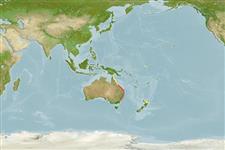>
Tetraodontiformes (Puffers and filefishes) >
Monacanthidae (Filefishes)
Etymology: Cantheschenia: Greek, kanthos = the outer or inner corner of the eye, where the lids meet, 1646 + Greek, schein, eko = to carry (Ref. 45335); grandisquamis: Name from the Latin word 'grandisquamis' (meaning large-scale), for the relatively large prominently outlined scales on the mid-side of the body.
Environment: milieu / climate zone / depth range / distribution range
Ecología
marino asociado a arrecife; rango de profundidad ? - 29 m (Ref. 58018). Temperate
Western Pacific: Capricorn Group to New South Wales, Australia.
Tamaño / Peso / Age
Maturity: Lm ? range ? - ? cm
Max length : 26.0 cm TL macho / no sexado; (Ref. 2334)
Radios blandos dorsales (total): 39; Radios blandos anales: 36; Vértebra: 19. Diagnosis: Relatively large scales on side of body with prominent outlines forming a reticulate pattern, each scale with many small spinules arranged in series radiating from a slightly larger central spinule. Soft dorsal rays 39, anal rays 36, pectoral rays 13. Color pattern consists of a dark brown to yellowish brown background with a patch of iridescent blue spots on side of throat and breast; a similarly colored line along basal sheath of both soft dorsal and anal fins, and upper and lower 4 rays of caudal fin dark blue, with a black bar along posterior margin, the remainder of fin yellow-orange (Ref. 35708).
In sheltered coastal and offshore reefs. Uncommon (Ref. 9710).
Life cycle and mating behavior
Madurez | Reproducción | Puesta | Huevos | Fecundidad | Larva
Randall, J.E., G.R. Allen and R.C. Steene, 1990. Fishes of the Great Barrier Reef and Coral Sea. University of Hawaii Press, Honolulu, Hawaii. 506 p. (Ref. 2334)
IUCN Red List Status (Ref. 130435)
Threat to humans
Harmless
Human uses
Más información
Nombres comunesSinónimosMetabolismoDespredadoresEcotoxicologíaReproducciónMadurezPuestaAgregación para la puestaFecundidadHuevosEgg development
Age/SizeCrecimientoLength-weightLength-lengthLength-frequenciesMorfometríaMorfologíaLarvaDinámica larvariaReclutamientoAbundanciaBRUVS
ReferenciasAcuiculturaPerfil de acuiculturaRazasGenéticaElectrophoresesheritabilidadEnfermedadesProcesamientoNutrientsMass conversion
ColaboradoresImágenesStamps, Coins Misc.SonidosCiguateraVelocidadTipo de nataciónSuperficie branquialOtolitosCerebrosVisión
Herramientas
Special reports
Download XML
Fuentes de Internet
Estimates based on models
Preferred temperature (Ref.
123201): 21.4 - 26.7, mean 25.2 °C (based on 181 cells).
Phylogenetic diversity index (Ref.
82804): PD
50 = 0.7500 [Uniqueness, from 0.5 = low to 2.0 = high].
Bayesian length-weight: a=0.01995 (0.00943 - 0.04220), b=2.93 (2.75 - 3.11), in cm total length, based on LWR estimates for this (Sub)family-body shape (Ref.
93245).
Nivel trófico (Ref.
69278): 2.8 ±0.4 se; based on size and trophs of closest relatives
Resiliencia (Ref.
120179): Medio, población duplicada en un tiempo mínimo de 1.4-4.4 años (Preliminary K or Fecundity.).
Fishing Vulnerability (Ref.
59153): Low vulnerability (16 of 100).
Nutrients (Ref.
124155): Calcium = 16.4 [6.1, 44.0] mg/100g; Iron = 0.236 [0.106, 0.577] mg/100g; Protein = 18.3 [16.0, 20.5] %; Omega3 = 0.256 [0.105, 0.555] g/100g; Selenium = 6.65 [2.66, 17.94] μg/100g; VitaminA = 39.9 [8.5, 197.8] μg/100g; Zinc = 0.645 [0.383, 1.122] mg/100g (wet weight);
